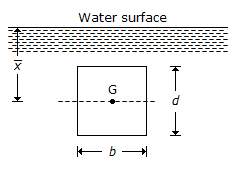Test: Hydraulics & Fluid Mechanics - 3 - Civil Engineering (CE) MCQ
25 Questions MCQ Test - Test: Hydraulics & Fluid Mechanics - 3
Reynold's number is the ratio of inertia force to
The unit of dynamic viscosity in S.I. units is
Bulk modulus of a fluid __________ as the pressure increases.
The hydraulic gradient line may be above or below the centre line of the pipe.
A water tank contains 1.3 m deep water. The pressure exerted by the water per metre length of the tank is
The depth of water in a channel corresponding to the minimum specific energy is known as critical depth.
The ratio of the inertia force to the gravity force is called Froude number.
A vertically immersed surface is shown in the below figure. The distance of its centre of pressure from the water surface is 
The Francis formula for the discharge over Cippoletti weir is
A manometer can be used to measure vacuum pressures.
Laminar flow __________ place at very low velocities.
The error in discharge (dQ/Q) to the error in measurement of head (dH/H) over a rectangular notch is given by
The tendency of a liquid to uplift a submerged body, because of the upward thrust of the liquid, is known as buoyancy.
An open tank containing liquid is made to move from rest with a uniform acceleration. The angle 0 which the free surface of liquid makes with the horizontal is such that (where a = Horizontal acceleration of the tank, and g = Acceleration due to gravity)
The discharge through an external mouthpiece is given by (where a = Cross-sectional area of the mouthpiece, and H = Height of liquid above the mouthpiece)
The loss of pressure head in case of laminar flow is proportional to
The flow of water through the hole in the bottom of a wash basin is an example of
A glass tube of smaller diameter is used while performing an experiment for the capillary rise of water because
The viscosity of a liquid is due to cohesion of its particles.
A compound pipe is required to be replaced by a new pipe. The two pipes are said to be equivalent, if
In a footstep bearing, if the speed of the shaft is doubled, then the torque required to overcome the viscous resistance will be
The viscosity of water is __________ than that of mercury.















